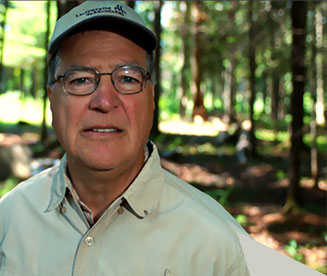Video produced by ArchAnge Films for the Sherbrooke Museum of Nature and Science
Narrator: Claude Chapdelaine, Professor Emeritus, Université de Montréal
Date: July 2015
Location: Cliche-Rancourt site, Lake Megantic, Quebec
Length: 2:33
Video of Claude Chapdelaine speaking to the camera and explaining the discoveries made at the Cliche-Rancourt site, as well as their impact on our understanding of human settlement. He also talks about the discovery of the first fluted point. In the background, the Cliche-Rancourt site.
Claude Chapdelaine speaks to the camera. In the background, which is a little blurry, is undergrowth with several trees.
[Claude Chapdelaine] Hello, I am Claude Chapdelaine. I am an archaeologist, a prehistorian, the director of the École de fouilles, and Anthropology professor at the Université de Montréal.
On-screen text: A profile of the archaeological discoveries at the Cliche-Rancourt site
[C.C.] We are at the Cliche-Rancourt site, the only known site in Quebec where archaeologists have found fluted points. Their presence indicates inhabitation from the Early Palaeoindian period, some 12 000 years ago.
On-screen: Photo of points, end scrapers, bifaces, and other tools.
[C.C.] These Palaeoindians settled on the Cliche-Rancourt site, occupying five different locations that have revealed a variety of remains, including points, end scrapers, bifaces…. These spots were used and inhabited on several different occasions. The Cliche-Rancourt site is the only site that enables us to write about this first chapter of human settlement in Quebec.
On-screen text: The impact of these discoveries on our understanding of human settlement.
On-screen: Two photographs of fluted points. In the blurry background, a person digging at an archaeological site.
[C.C.] The discovery of fluted points at the Cliche-Rancourt site has enabled us today to include Quebec as part of the great mystery of the human settlement of northeastern America. We believe that the first people from the south migrated north towards the Lake Megantic region to hunt caribou in early fall. We can confirm that populations were adapted to quite a cold climate where tundra was prevalent. The Cliche-Rancourt site is part of this vast network that can be studied through the lithic materials that were carved and used on the Cliche-Rancourt site.
On-screen text: An anecdote.
On-screen image of a fluted point. In the background, an image of a person holding a point in their hands and an image of hands digging a hole at an archaeological site.
[C.C.] The highlight at the Cliche-Rancourt site was the discovery of the first fluted point, and two days later, of a shard from this flute that could be matched to the point. At the time, we were very proud to have discovered the first Early Palaeoindian site containing the famous fluted points. This discovery also revealed that three years earlier, I had made a colossal mistake at a scientific symposium, when I had concluded that we were not likely to find traces of fluted points in Quebec in the 21st century. In August 2003, I was very happy to have been proved wrong.






